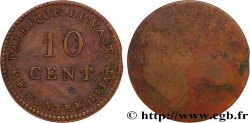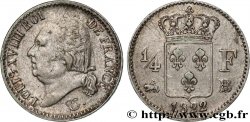fmd_153541 - 10 cent. Anvers au double L, frappe de l’arsenal de la marine 1814 Anvers F.130D/1 var.
无库存.
所有在网站上销售的产品
价格 : 120.00 €
所有在网站上销售的产品
价格 : 120.00 €
种类 10 cent. Anvers au double L, frappe de l’arsenal de la marine
日期: 1814
铸币厂名称/城市 Anvers
铸币数量 ---
材质 bronze
直径 34 mm
模子方针 12 h.
重量 22,01 g.
侧面 cannelée
稀少度 R2
关于品相的说明
Très fines stries au revers dans le champ comme habituellement sur ces types. Frappe légèrement décentrée vers le haut. Belle patine marron
正面
正面的文字 ANVERS / 1814.
正面的说明书 Au centre deux L croisées et affrontées dans une couronne formée de deux branches d'olivier nouées à leur base par un ruban sur lequel se trouve la signature JEAN-LOUIS/ GAGNEPAIN du graveur.
背面
背面的文字 MONNAIE / OBSIDIONALE.
背面的说明书 Au centre 10 / CENT..
评论
Pas de point après 1814 ; la branche gauche se termine par deux feuilles entre lesquelles s’insère légèrement une feuille terminale droite. Frappe médaille. Cet exemplaire comporte aussi une tranche cannelée comme l’exemplaire MONNAIES XXIII n° 1681. Paul Bordeaux, “La médaille frappée en l’honneur de Pierre Lair à Anvers en 1814 et les monnaies obsidionales émises à la même époque”, Revue belge de numismatique, 1906, p.181-205 et 309-338 pensait que les ateliers de l’Arsenal “possédaient certainement une glissière-rabot, dénommée raquette en termes techniques du métier, permettant de faire rapidement à volonté des cannelures de ce genre sur certaines épreuves ou sur quelques-unes des pièces courantes” : extrait cité par Maurice Colaert en 2001 qui met en doute cette affirmation. Selon lui, ces cannelures sont postérieures et rien ne permet de croire que l’atelier de l’Arsenal possédait le matériel adéquat. Nous sommes plutôt favorable à l’hypothèse Bordeaux : en raison de légers replis sur les bords de cette tranche, nous sommes portés à croire que ce marquage de tranche est antérieur à la frappe. Ces replis de métal sont clairement au-dessus des cannelures. Notre exemplaire est très certainement un essai de tranche, procédé qui a été abandonné suite à son inutilité ou à la perte de temps induite.








 对产品描述纠错
对产品描述纠错 打印
打印 分享我的选择
分享我的选择 提问
提问 Consign / sell
Consign / sell
 产品介绍
产品介绍









